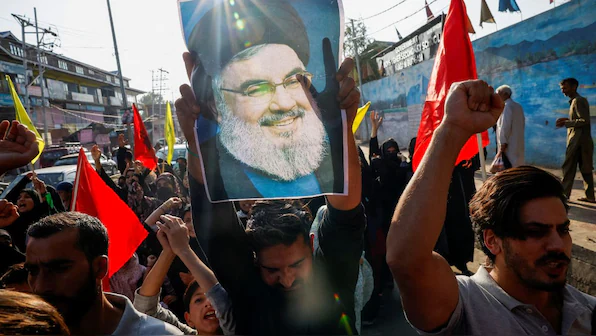Following the death of Hassan Nasrallah, the leader of the Lebanon-based terrorist organisation Hezbollah, several regions in India witnessed gatherings and protests by Shia Muslims who paid tribute to the controversial figure during Friday prayers. Nasrallah, a key figure in Hezbollah’s fight against Israel, was killed during an Israeli airstrike on September 27, 2024. His death has ignited strong emotions, particularly among members of the Shia Muslim community, who revered him as a martyr.
Mourning in Chhapra and Muzaffarpur, Bihar
In Chhapra, Bihar, the Shia community organised a mourning ceremony on Friday, October 4, 2024, at the Shia Imambara in Dahiyawan. The ceremony took place after the night prayers, where a large group of Shia Muslims gathered to honour Nasrallah’s memory. The attendees carried placards and portraits of Nasrallah, expressing their sorrow over his death.
At the Imambara, a candle was lit in front of Nasrallah’s photograph, and the Fatiha, a special prayer for the deceased, was recited. The chief cleric of the Shia mosque, Syed Masoom Raza, spoke passionately about Nasrallah’s legacy. “He gave his life as a martyr for his community. He was not a jihadist in the terrorist sense; he fought for the rights of the poor. He was a jihadist for justice,” Raza proclaimed to the crowd. Many in attendance echoed these sentiments, referring to both Nasrallah and his daughter as the greatest martyrs of the century.
Similarly, in Muzaffarpur, another significant Shia population centre in Bihar, protests erupted against the widespread portrayal of Nasrallah as a terrorist. Led by Shia cleric Syed Mohammad Kazim Shabib, a candlelight march was organised, starting from Kamra Mohalla Imam Chowk and concluding at Saraiyaganj Tower. Hundreds of Shia Muslims participated, holding aloft images of Nasrallah while chanting slogans condemning Israel. The cleric and his followers labelled Nasrallah a martyr who bravely fought against Israeli aggression.
“People are calling him a terrorist, which is a gross misrepresentation of what he stood for,” said Maulana Kazim Shabib during the march. “He was fighting against an oppressive regime. His cause was just.”
Widespread mourning beyond Bihar
The mourning for Nasrallah’s death extended far beyond Bihar. From Lucknow in Uttar Pradesh to Kashmir, the Shia community expressed deep sorrow. In Lucknow, the mourning was so significant that a three-day period of mourning was declared in Nasrallah’s honour. Black flags were hoisted, and congregational prayers were held across the city’s Shia neighbourhoods, with clerics leading the crowds in lamenting Nasrallah’s death.
The political repercussions of Nasrallah’s death were felt in Kashmir as well. Mehbooba Mufti, the former Chief Minister of Jammu and Kashmir, and Ruhullah Mehdi, a National Conference Party Member of Parliament representing the Srinagar Lok Sabha seat, temporarily halted their election campaigns to honour the Hezbollah leader’s memory. Their decision to stop campaigning reflects the deep connection many within the Shia community in the region have with Nasrallah and Hezbollah’s cause.
Demonstrations and protests in Tamil Nadu
In southern India, particularly in Chennai, the capital of Tamil Nadu, Shia Muslims gathered to honor Nasrallah. Posters of the Hezbollah leader were placed outside mosques, and several public tributes were held in his memory. These gatherings, though peaceful, attracted attention due to the public display of support for a figure internationally recognised as a terrorist leader. The posters portrayed Nasrallah as a martyr and a hero in the fight against Israel, reflecting the sentiments held by his supporters.
The Israeli airstrike that killed Nasrallah
The death of Hassan Nasrallah was a significant development in the ongoing conflict between Israel and Hezbollah. On September 27, 2024, Israeli forces carried out a precision airstrike on Hezbollah’s headquarters in Southern Beirut, Lebanon, dropping 80 tons of bombs on the underground facility where Nasrallah and several top Hezbollah leaders were reportedly meeting. The strike not only eliminated Nasrallah but also severely damaged Hezbollah’s leadership structure.
According to Israeli military officials, Nasrallah was in a secure underground bunker during a meeting with his senior commanders when the strike occurred. The operation, part of Israel’s broader campaign to dismantle Hezbollah, was conducted after months of intelligence gathering. Israeli sources claim that Hezbollah has suffered significant losses in leadership over the past few months, making this strike a decisive blow.
End of Hezbollah’s leadership
Nasrallah’s death follows a series of targeted killings by Israel aimed at eradicating Hezbollah’s top commanders. Earlier, on July 30, 2024, Israeli forces killed Fouad Shukr, Hezbollah’s second-in-command, in another airstrike. The following day, on July 31, 2024, Israeli forces assassinated Ismail Haniyeh, the leader of the Palestinian terrorist group Hamas, during an operation in Iran.
These coordinated strikes have left Hezbollah and Hamas without their key leaders, significantly weakening their operational capacities. With Nasrallah and Shukr now dead, Hezbollah is without a senior leadership figure to command the organisation. Meanwhile, in Hamas, only Yahya Sinwar remains alive among its top echelon of leaders.
Tensions rise amid tributes and protests
The public mourning of Nasrallah in India has raised concerns among law enforcement agencies about the potential for heightened sectarian tensions, particularly between Shia and Sunni communities. The tributes to Nasrallah have not been universally supported, with many criticising the glorification of a leader whose organisation has been involved in acts of terrorism across the Middle East.



















Comments